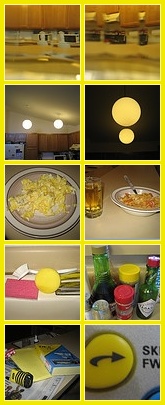Everything’s Gone (Curious) Yellow
Posted on | April 28, 2007 at 6:28 pm | 3 Comments
 I have these huge light fixture globes in my kitchen, hanging from the vaulted ceiling. It’s difficult to change the bulbs in them. I’ve been using 150 watt incandescent bulbs. I like a lot of light, especially since the Lasik. Makes it easier to read. The incandescent bulbs burn out about once a year or so.
I have these huge light fixture globes in my kitchen, hanging from the vaulted ceiling. It’s difficult to change the bulbs in them. I’ve been using 150 watt incandescent bulbs. I like a lot of light, especially since the Lasik. Makes it easier to read. The incandescent bulbs burn out about once a year or so.
Well, since I’m all about saving the planet and everything, I decided to try out some compact fluorescent bulbs in the fixtures. The highest “wattage” available are 100 equivalents (which are actually 26 watts). I got the GE general purpose Soft White 100 spirals (I had a three pack that I got cheap). I do notice they are not as bright as the incandescent ones, and they take a little bit of time to turn on and warm up, but that doesn’t bother me. The weird thing is that they color everything differently. Everything that is yellow looks even yellower – very vivid, almost like HiDef. And everything non-yellow now has a bit of a yellow tint to it. Whatever happened to “soft white“? Anyway, I made a Flickr photo set showing my kitchen bathed in the new compact fluorescent glow, including a lot of yellow things. Of course, the camera distorts the color (especially when the flash is used), so the pix are not an entirely accurate depiction. Still, you might get the idea.
(Hey, check out summervillain’s interesting post about CF bulbs while you’re here.)
Latre.
Comments
3 Responses to “Everything’s Gone (Curious) Yellow”
April 29th, 2007 @ 7:08 pm
Color quality is a big issue with lighting. In commercial fixtures you can get fluourescent lights that are a lot “bluer”.
April 29th, 2007 @ 8:24 pm
Color quality is a big issue with lighting.
So I’m beginning to learn…
My friend Phil sent me an e-mail about CFLs after reading this entry. Since it has a lot of good info in it, I’m hereby posting part of it without his permission, but I don’t think he would care. Phil, if you care, let me know and I’ll remove it.
Here’s what Phil says:
—————————————–
There are much brighter CFL’s available than those GE bulbs you linked to. Those are 1750 initial lumens, where as these for example are 6900 lumens. Also, that GE bulb is a 2700K color temperature, which is the yellowest color available. Personally, I think it’s nasty and prefer bulbs with 5000K or higher. Or at least 4100K if nothing higher is available, which is sometimes the case with pin type (as opposed to screw-in) CFL’s. Here in government-crazy California, screw-in bulbs (even CFL’s) are prohibited in certain rooms (for no reason that makes any sense whatsoever). So in those rooms/situations you have to use pin-type fluorescent or non-screw-in LED’s. We’re using this in all our ceiling “can lights”, and it looks good. It has a different shape (called “widespring” or “flower”) than the usual spiral bulbs, that fits nicely in the fixture.
Esthetically, it is generally a good idea to have all your lighting that’s in view from one particular location at the same (or similar) Kelvin color values (and with CRI’s higher than 79). Mixing different color lights usually looks bad.
Also, that is a myth that you save energy leaving a fluorescent light on. (They even tested this on the Discovery Channel show Mythbusters.) The start-up power of a modern fluorescent (i.e. with electronic ballast) is very small. However, the number of starts is a significant factor in the lifespan of the bulb. So leaving a fluorescent light on rather than turning it off for short (or even long) periods of time can extend the life. Good to know for hard-to-reach bulbs.
Another thing to know about fluorescents is they get dimmer with age. While a brand new incandescent light looks pretty much like one that’s a nanosecond away from burning out, an older fluorescent will be noticeably dimmer and, for many types, different in color. For most pleasing results, one might have to replace a CFL before it actually fails to function; and CFL’s in groups might be best replaced in unison.
——————————————
April 29th, 2007 @ 11:11 pm
It’s also worth noting that just as some states and countries are considering laws to BAN incandescent lights, some companies are developing new high-efficiency technologies to make flourescents obsolete (I don’t wanna plug someone else’s blog on here, just Google it)
Me, I’m gonna keep my eyes on the lights that makes all of the others look sick – LEDs. They’re not quite ideal for area lighting yet but it won’t be forever…